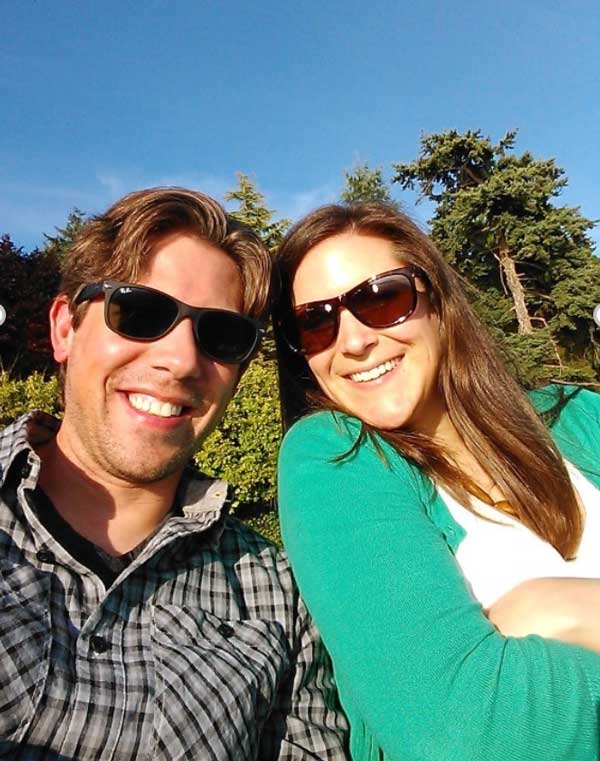Last year I sat in the offices of several “lean champions” at their companies, agents of change who are trying to instill lean thinking throughout their organizations. Each had been in the role for years. A hallmark of their offices was a corner filled with rolled up flip chart papers – artifacts of past lean activities like value-stream maps. And a hallmark of our conversations were expressions of frustration with others who were not sustaining changes or choosing to make any in the first place. I could relate.
Over the holidays, I spent time reflecting like everyone else. But this year I looked back over ten years, prompted by the 2010s becoming the 2020s. In terms of lean thinking, the 2010s was a decade of practice for me. Admittedly my emphasis on practice has grown over the years. Ten years from now I’ll probably use bold if not ALL CAPS too! I knew a lot in 2010. I know much less in 2020.

Josh Howell and wife, Christy
A Personal Turning Point
As I reflected a single memory kept coming to mind. An image really. In a photo my wife and I are sitting on a park bench in Seattle overlooking the Puget Sound, an inlet of the Pacific Ocean that abuts the city. Our big smiles are framed by evergreens found all over the Pacific Northwest and a clear blue sky. Locals would say, “The mountains are out!” It was early June 2013. We look happy, minutes away from starting a meandering four-day drive along every mile of Interstate 90 between Seattle and Boston.
My last day working for Starbucks was a recent memory. I would soon be working for the Lean Enterprise Institute. I was anticipating a dream coming true. But LEI was not real yet. I could only imagine working there. That was not the reason for the smile on my face. That was because I was leaving Starbucks.
I had worked there for nine years, the last five as a change agent trying desperately to ignite lean thinking for roughly 200,000 employees working hard worldwide. As part of a small “lean team” that maxed out at a dozen people, I contributed to the redesign of retail store operations and the recast of store and upper-level line managers from implementers of solutions from headquarters to coaches of local problem-solving teams. And progress was being made toward that ideal image.
Yet a series of interactions with various naysayers, including some key executives, and my view of other developments at the company had me feeling like its lean initiative was doomed. In fact, the lean team was disbanded a month or so after I left; its members were reassigned to other teams throughout the broader “retail store services” organization. It was a tell-tale sign of a failed lean implementation. Or was it?
Lean Thinking at Starbucks
The overarching objective for “Lean at Starbucks” when I got involved circa 2008 was to help the company survive during a global economic crisis by improving the Starbucks Experience for customers and partners (the company’s term for employees) and delivering necessary cost reductions. The crisis was existential. You may remember the company closing hundreds of stores at that time. But while cost was a major problem, it wasn’t the only one. It wasn’t even the primary one.
Paraphrasing, Howard Schultz described the problem in his 2011 book Onward by saying the company had lost its soul, the very essence of what the company aspired to be – the “third place” (not home, not work, but the other place where people gather) with coffee at the center. He also saw that solving this problem with its myriad smaller problems was a leverage-able opportunity that could strengthen the company for the long-term. He kept saying we’d emerge from the crisis stronger than ever. In the minds of lean thinkers, strength comes from instilling PDCA into everything we do, creating a foundation for continuous improvement. That’s what my team and I were trying to accomplish. The question is, did we?
An Evolving Perspective
My working answer today is yes. If I start by looking back on what was happening in 2013 when I left the company, hindsight (it is 2020 after all) allows me to see the disbanding of a formal lean team as a net positive. The truth is this particular lean team was often isolated, doing its own thing as if it knew better than everyone else. As you can imagine this did not make us very popular, inhibiting our effectiveness at working with and influencing others. Plus, one team had a lot of the company’s capability for lean thinking. Disbanding the team redistributed and embedded that capability throughout a key department that supports store operations and teams.
Unfortunately for Starbucks, in my opinion anyway, six years later almost every one of those capable lean practitioners no longer works for the company. For example, Hollie Jensen went on to become the director of continuous improvement for the State of Washington and is now the business transformation designer for Alaska Airlines. Steve Crowley is the global director for retail operations at Anheuser-Busch InBev and Co-Founder of Service Physics. And that’s naming only two of my former colleagues.
Then again, if I look at the company today, albeit from a distance, the company keeps pushing to improve the Starbucks Experience. One piece of evidence is their commitment to Starbucks Mobile Order & Pay. In spite of its complications, it represents a customer-first mindset by making the Experience more convenient. It also provides a lot of valuable data that can keep fueling customer-driven improvement. The company also possesses a growth mindset, valuing organizational learning as a key competency. For evidence of that, check out this video of current CEO Kevin Johnson touring the company’s Tryer Center. Lean thinking at Starbucks.
But What About the Value Creators?
Because I no longer work for the company and spend minimal time in stores as a customer only, what I can’t observe is what’s happening behind the scenes for the folks who work there. Are they experiencing a better way of working? Are they learning how to solve the inevitable problems in their work? Are they allowed to try and fail in pursuit of even better ways of working that are situationally appropriate to their unique store? Are they given the resources, support, and coaching necessary?
I hope so but I can’t say for sure. In fact, I couldn’t have said for sure even when I worked there and lean at Starbucks was a major and formal initiative. Starbucks is a huge company.
And What About the Lean Champions?
Thinking again about my conversations with lean champions including conversations with myself, I recognize a few tendencies. First, lean champions can be so close to what’s happening now that what’s already changed and gotten better goes unrecognized. Second, they define near-term goals in terms of what’s possible, or worse, what Toyota achieved over many decades. And third, they get fixated on what they think should be happening that whatever’s actually happening seems “wrong”, even when more value is being created, fewer resources are being consumed, and more people are making things better.
In my opinion, these tendencies are important for lean champions to recognize. They frame the challenge in a not-so-helpful way, making a difficult role even more so. Not even the grittiest person can succeed when this is their perspective.
Actually, I’d like to add a fourth tendency to the list. One that’s even more pernicious. It’s the tendency to only reflect externally (vs. internally), to focus on what others are or are not doing (vs. taking a hard look at one’s self). After all, you can only control your thinking and actions. When I left Starbucks, if I’m being honest with myself, all of my reflections were externally focused. I was frustrated with my leaders, my colleagues, and the company. I was even frustrated with Seattle(!) like it had anything to do with it. And thus my smile in that damn photo.
Personal Improvement
In my six and a half years at LEI, I have developed my capability to self-reflect as much as anything else. And let me tell you, at times it’s been painful. I wrote about one particular experience here on the Lean Post. On the other hand, a not-at-all painful memory comes from the Lean Coaching Summit in Seattle in 2018. John Shook was kicking things off one morning with a co-presenter who used to be his manager when he worked for Toyota. When it was time to start, his co-presenter was nowhere to be found. It turned out he had overslept. It was a stressful situation as you can imagine. When his co-presenter finally did show up and took the stage, instead of focusing on him, John focused on himself. Reflecting out loud he said (paraphrasing), “I failed to confirm the start time with you last night, and to check on how you’d wake up. And then, I didn’t suggest we meet beforehand this morning. That would have allowed me to check on you again before it was too late. I’ll do better next time.” I was blown away.
So in the year 2020, as lean champions, coaches, thinkers, and practitioners, let’s look out for these tendencies in ourselves and our colleagues. Let’s help each other frame our challenges in a helpful (and healthy) way. And let’s ensure that a) reflection is happening, b) good outcomes and how those are achieved are recognized and reflected on too, and c) that reflection focuses on that which we can control – ourselves. Self-reflection, I believe, is the only way that improvement happens. If you aren’t getting better, you can’t expect the same from others.
Cheers to making a great 2020! One self-reflection at a time.
Josh
Josh Howell
President, LEI
Boston, Massachusetts
P.S. (Shameless advertising alert!) Speaking of long-term efforts to positively influence organizations with lean thinking, the Lean Summit 2020 will take place in California on April 6th and 7th. Its theme will be “Grit and Perseverance.” You can learn about it and register here. If I could invite 2012 Josh Howell to the Summit, I would. Maybe he’d stick it out with Starbucks, turning his critical eye inward, and giving his fellow partners more of a break.




